5G Base Station Market Size
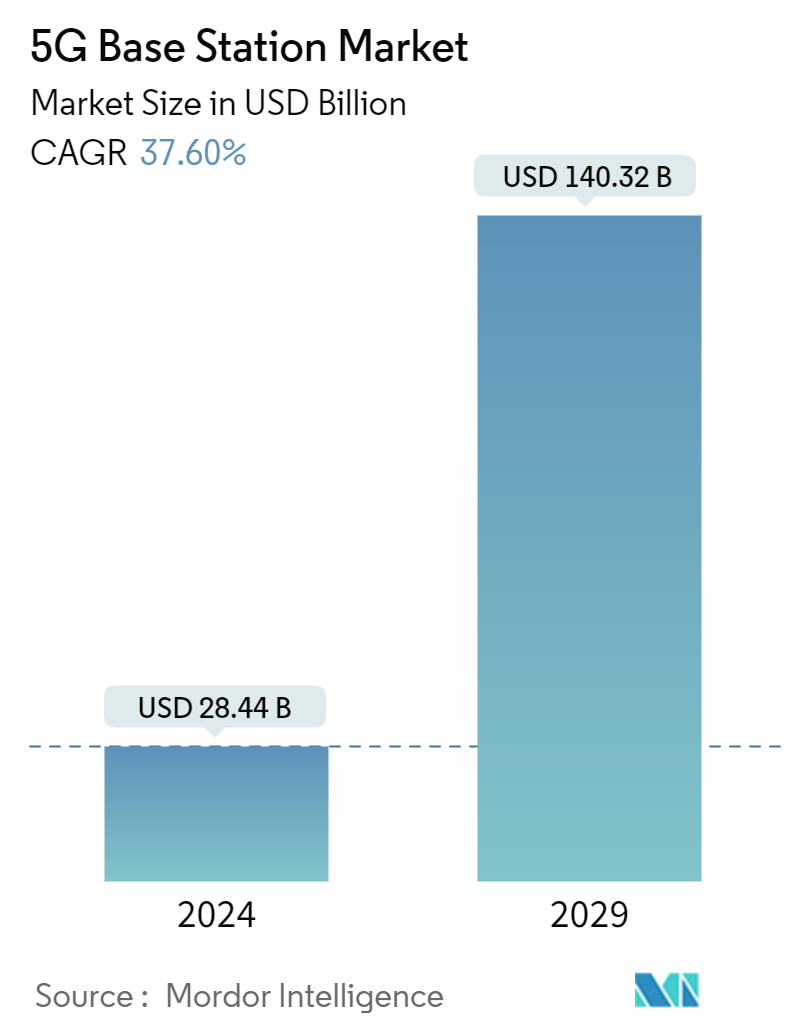
| Study Period | 2019 - 2029 |
| Market Size (2024) | USD 28.44 Billion |
| Market Size (2029) | USD 140.32 Billion |
| CAGR (2024 - 2029) | 37.60 % |
| Fastest Growing Market | Asia Pacific |
| Largest Market | Asia Pacific |
Major Players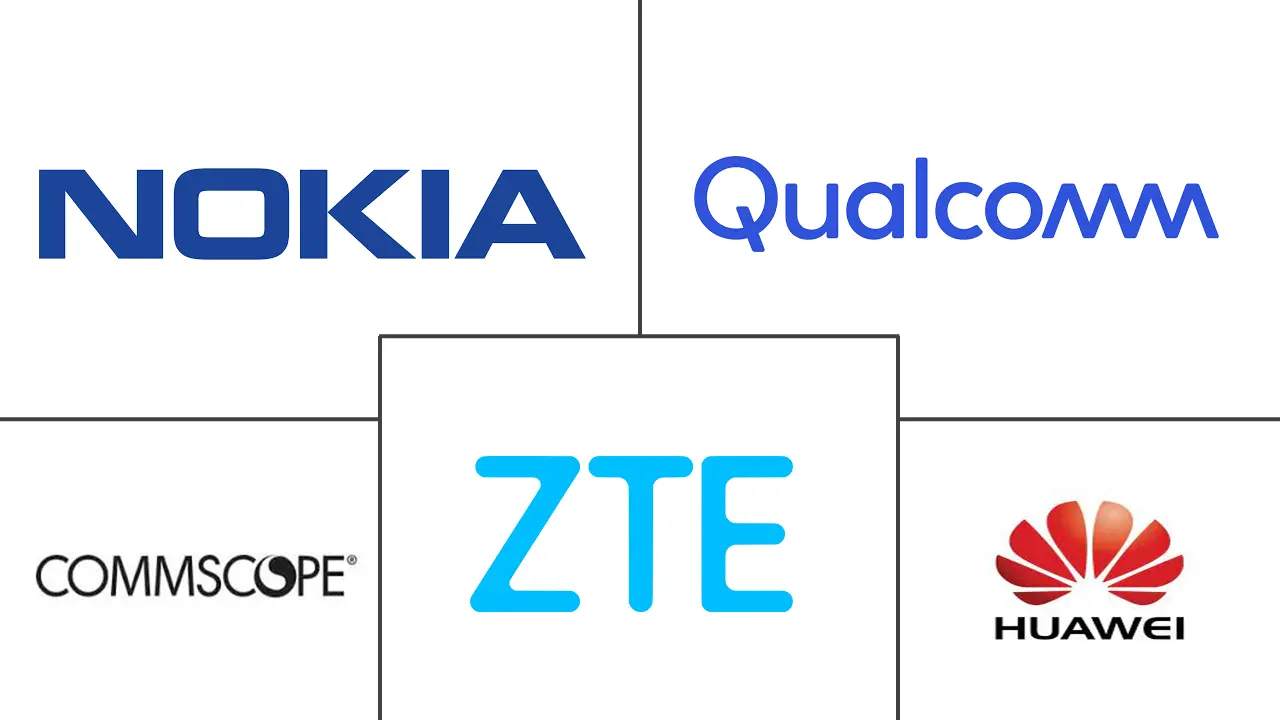
*Disclaimer: Major Players sorted in no particular order |
5G Base Station Market Analysis
The 5G Base Station Market size is estimated at USD 28.44 billion in 2024, and is expected to reach USD 140.32 billion by 2029, growing at a CAGR of 37.60% during the forecast period (2024-2029).
The 5G base station market has experienced significant growth in recent years because of the strong need for high-speed network connectivity. The smartphone ownership rate steadily rises each year in advanced and emerging economies. Utilizing advanced technologies such as AR and VR, brands can enhance their customers' shopping experience with the help of 5G networks, assisting them in finding the most suitable product for their requirements.
- 5G technology provides a much lower latency rate, which is the time it takes to receive and send information. Reducing overall latency enhances user satisfaction and opens up new possibilities for creative applications.
- Additionally, there is a movement toward ultra-reliable low latency communications (URLLC) within the 5G network design realm. This feature allows for optimal organization of data exchanges. It supports high-level services like factory automation, industrial internet, smart grid, autonomous driving, and robotic surgeries. Therefore, the increasing need for faster response times in the mentioned applications is greatly driving the expansion of the worldwide 5G base station industry.
- 5G technology can significantly enhance public safety and security in smart cities. Intelligent city networks can gather and examine vast quantities of information from different origins, such as video cameras, intelligent traffic lights, and other Internet of Things (IoT) devices, through the fast and effective 5G network.
- Additionally, IoT networks utilizing 5G technology would enable faster communication among interconnected devices due to 5G speeds reaching up to 1 Gbps. Therefore, IoT systems and devices linked to 5G will be extremely precise when performing time-sensitive tasks.
- The expenses for setting up the necessary 5G infrastructure and upgrading software are significantly high due to the large number of BTS units needed for continuous 5G service delivery. Successful implementation of the 5G network could necessitate significant upgrades in cell sites, connective nodes, central switches, software, and mobile devices.
5G Base Station Market Trends
Smart Cities to Witness Major Growth
- 5G technology is an enabling technology for IoT, and as smart cities essentially rely on IoT, the demand for 5G base stations is driven by the growing use cases of 5G in smart cities.
- In addition, the combination of high density and low latency offered by 5G technology will deeply transform smart cities, thus further indicating strong demand for 5G base stations in smart city applications worldwide.
- Small cells are analyzed by type to hold a significant share in the smart cities segment during the forecast period. The small cells are low-power base stations vital to providing coverage and capacity in specific locations, such as streets, buildings, and malls, thus gaining significant traction in smart city applications.
- Further, the role of a small cell 5G base station is becoming paramount to roll out technologies such as 5G in smart cities. Market vendors recognize the need to deploy small cells to increase the capacity and coverage of mobile networks in dense cities. Such developments are analyzed to help city councils in smart city planning and subsequently drive the market's growth.
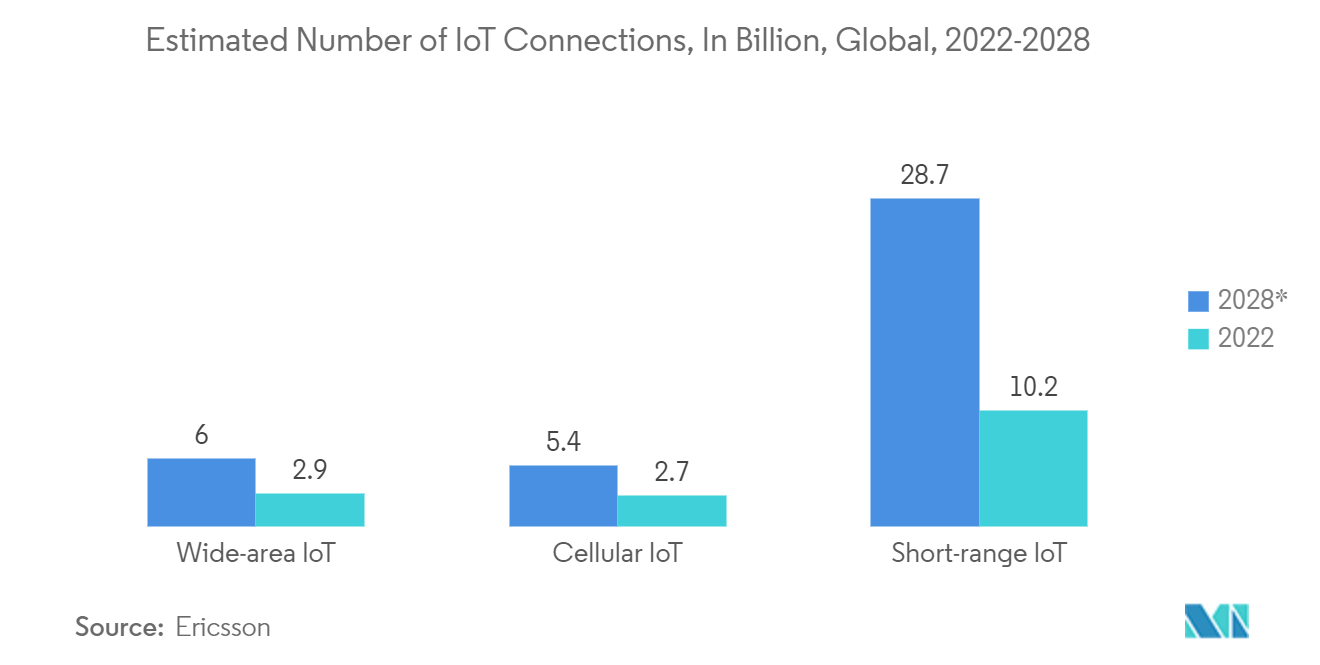
Asia-Pacific to Register Major Growth
- Asia-Pacific's robust investments in 5G technology, spearheaded by companies like Huawei and ZTE Corporation, fuel the rapid deployment of 5G base stations. Additionally, government initiatives, a push for digitization, and high smartphone penetration in Asia-Pacific nations are bolstering the demand for 5G base stations.
- By the close of 2023, China had a staggering 805 million 5G users, as the Ministry of Industry and Information Technology (MIIT) reported. Also, the GSMA predicts that by 2025, 40-50% of China's mobile users could be on 5G networks. These statistics underscore the robust deployment of 5G base stations by market vendors in China.
- The industrial sector, particularly in Japan, China, and South Korea, is expected to drive 5G base station growth in Asia-Pacific. The rising adoption of IoT and Industry 4.0 in these countries fuels demand for 5G base stations, enabling industrial automation and smart factory solutions.
- Asia-Pacific is poised for robust growth in the global 5G base station market. This growth is underpinned by several factors, including strong governmental support for rapid 5G deployment, an expanding 5G user base, increasing tech adoption in end-user industries, and a surging demand for high-speed, low-latency connectivity across the region.
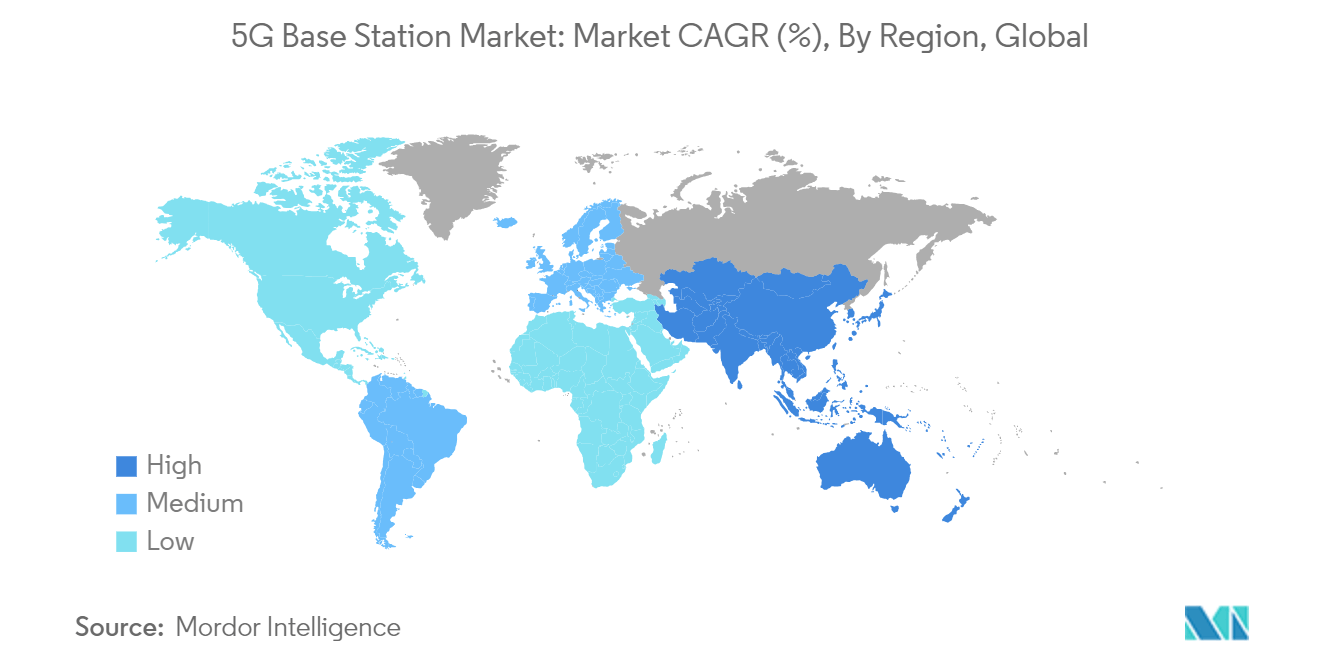
5G Base Station Industry Overview
The 5G base station market is fragmented with several players like Huawei Technologies Co. Ltd, ZTE Corporation, Nokia Corporation, CommScope Holding Company Inc., and Qualcomm Technologies Inc. The firm concentration ratio is expected to grow more during the forecast period because several firms consider this market a lucrative opportunity to expand globally.
- In February 2024, Dell Technologies and Nokia announced an extension of their strategic collaboration. This partnership leverages Dell's infrastructure solutions and Nokia's expertise in private wireless connectivity to propel open network architectures and enable private 5G applications for businesses. This move is set to bolster Nokia's position in the 5G base station market, given its prowess in developing base station products for 5G networks.
- In September 2023, Ericsson and Telefonica signed an MoU for Cloud RAN evolution based on Open RAN architecture, showing that Ericsson Cloud RAN would offer significant opportunities for communications service providers to build macro networks to expand their 5G into enterprise applications, showing the demand for macro cell-based 5G infrastructure demand in the market, which would support the growth of microcell base stations in the future.
5G Base Station Market Leaders
-
Huawei Technologies Co., Ltd.
-
ZTE Corporation
-
Nokia Corporation
-
CommScope Holding Company, Inc.
-
QUALCOMM Incorporated
*Disclaimer: Major Players sorted in no particular order
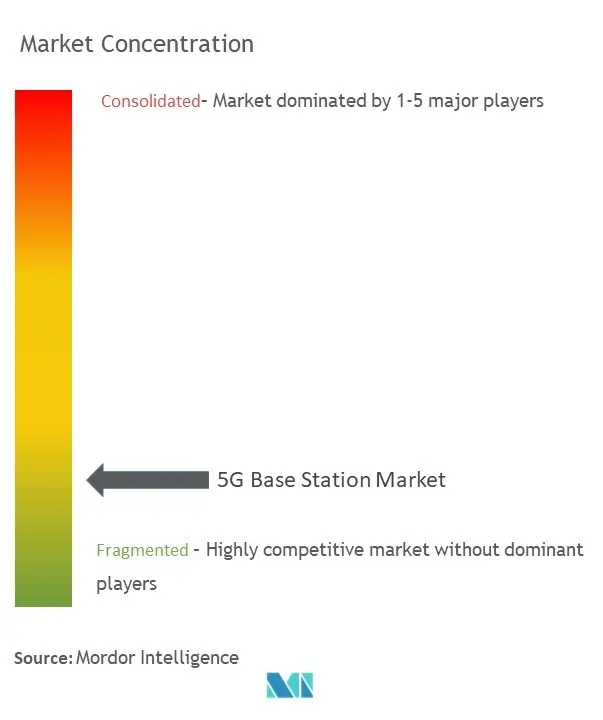
5G Base Station Market News
- September 2023: NEC Corporation India announced the launch of a smart city project in Tirupati for Tirupati Smart City Corporation. Under this Smart City project, the company will implement information communication technology (ICT) services throughout Tirupati and the security operations center in Tirupati.
- August 2023: Reliance Jio announced that it completed the 5G rollout across all 22 telecom circles using the 26GHz mmWave spectrum. With this, Reliance Jio completed the minimum rollout obligations for 5G connectivity across all the spectrum bands for the range acquired in the 2022 spectrum auction.
5G Base Station Market Report - Table of Contents
1. INTRODUCTION
- 1.1 Study Assumptions and Market Definition
- 1.2 Scope of the Study
2. RESEARCH METHODOLOGY
3. EXECUTIVE SUMMARY
4. MARKET INSIGHTS
- 4.1 Market Overview
-
4.2 Industry Attractiveness - Porter's Five Forces Analysis
- 4.2.1 Bargaining Power of Suppliers
- 4.2.2 Bargaining Power of Buyers
- 4.2.3 Threat of New Entrants
- 4.2.4 Intensity of Competitive Rivalry
- 4.2.5 Threat of Substitute Products
5. MARKET DYNAMICS
-
5.1 Market Drivers
- 5.1.1 Increase in Penetration Rate of Smartphones
- 5.1.2 Key Benefits Offered by 5G over its Predecessors
-
5.2 Market Challenges
- 5.2.1 Design and Operational Challenges
-
5.3 Market Opportunities
- 5.3.1 Ongoing Efforts Toward The Introduction of 5G in Emerging Countries
6. MARKET SEGMENTATION
-
6.1 By Type
- 6.1.1 Small Cell
- 6.1.2 Macro Cell
-
6.2 By End User
- 6.2.1 Commercial
- 6.2.2 Residential
- 6.2.3 Industrial
- 6.2.4 Government
- 6.2.5 Smart Cities
- 6.2.6 Other End Users
-
6.3 By Geography***
- 6.3.1 North America
- 6.3.2 Europe
- 6.3.3 Asia
- 6.3.4 Australia and New Zealand
- 6.3.5 Latin America
- 6.3.6 Middle East and Africa
7. COMPETITIVE LANDSCAPE
-
7.1 Company Profiles*
- 7.1.1 Huawei Technologies Co. Ltd
- 7.1.2 ZTE Corporation
- 7.1.3 Nokia Corporation
- 7.1.4 CommScope Holding Company Inc.
- 7.1.5 QUALCOMM Incorporated
- 7.1.6 Qorvo Inc.
- 7.1.7 Alpha Networks Inc.
- 7.1.8 NEC Corporation
- 7.1.9 Telefonaktiebolaget LM Ericsson
- 7.1.10 Samsung Electronics Co. Ltd
8. INVESTMENT ANALYSIS
9. FUTURE OF THE MARKET
** Subject To Availablity5G Base Station Industry Segmentation
The 5G base station is a fixed communication equipment that connects using a single or several antennas. It includes a wireless receiver and a small-range transceiver with an antenna and analog-to-digital converters to transform radio frequency impulses into digital signals. The 5G base station primarily focuses on high-bandwidth and high-traffic-usage scenarios and real-time communications with high reliability and latency requirements.
The 5G base station market is segmented by type (small cell and macro cell), end user (commercial, residential, industrial, government, smart cities, and other end users), and geography (North America, Europe, Asia-Pacific, Middle East and Africa, and Latin America). The market sizes and forecasts are provided in terms of value (USD) for all the above segments.
| By Type | Small Cell |
| Macro Cell | |
| By End User | Commercial |
| Residential | |
| Industrial | |
| Government | |
| Smart Cities | |
| Other End Users | |
| By Geography*** | North America |
| Europe | |
| Asia | |
| Australia and New Zealand | |
| Latin America | |
| Middle East and Africa |
5G Base Station Market Research FAQs
How big is the 5G Base Station Market?
The 5G Base Station Market size is expected to reach USD 28.44 billion in 2024 and grow at a CAGR of 37.60% to reach USD 140.32 billion by 2029.
What is the current 5G Base Station Market size?
In 2024, the 5G Base Station Market size is expected to reach USD 28.44 billion.
Who are the key players in 5G Base Station Market?
Huawei Technologies Co., Ltd., ZTE Corporation, Nokia Corporation, CommScope Holding Company, Inc. and QUALCOMM Incorporated are the major companies operating in the 5G Base Station Market.
Which is the fastest growing region in 5G Base Station Market?
Asia Pacific is estimated to grow at the highest CAGR over the forecast period (2024-2029).
Which region has the biggest share in 5G Base Station Market?
In 2024, the Asia Pacific accounts for the largest market share in 5G Base Station Market.
What years does this 5G Base Station Market cover, and what was the market size in 2023?
In 2023, the 5G Base Station Market size was estimated at USD 17.75 billion. The report covers the 5G Base Station Market historical market size for years: 2019, 2020, 2021, 2022 and 2023. The report also forecasts the 5G Base Station Market size for years: 2024, 2025, 2026, 2027, 2028 and 2029.
5G Base Station Industry Report
Statistics for the 2024 5G Base Station market share, size and revenue growth rate, created by Mordor Intelligence™ Industry Reports. 5G Base Station analysis includes a market forecast outlook to for 2024 to 2029 and historical overview. Get a sample of this industry analysis as a free report PDF download.



